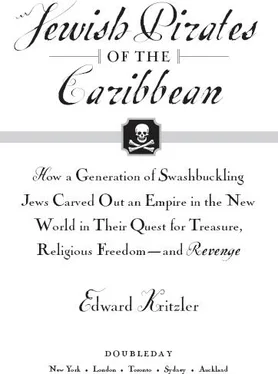Edward Kritzler - Jewish Pirates of the Caribbean
Здесь есть возможность читать онлайн «Edward Kritzler - Jewish Pirates of the Caribbean» весь текст электронной книги совершенно бесплатно (целиком полную версию без сокращений). В некоторых случаях можно слушать аудио, скачать через торрент в формате fb2 и присутствует краткое содержание. Год выпуска: 2008, ISBN: 2008, Издательство: Knopf Doubleday Publishing Group, Жанр: Старинная литература, на английском языке. Описание произведения, (предисловие) а так же отзывы посетителей доступны на портале библиотеки ЛибКат.
- Название:Jewish Pirates of the Caribbean
- Автор:
- Издательство:Knopf Doubleday Publishing Group
- Жанр:
- Год:2008
- ISBN:9780385528368
- Рейтинг книги:3 / 5. Голосов: 1
-
Избранное:Добавить в избранное
- Отзывы:
-
Ваша оценка:
- 60
- 1
- 2
- 3
- 4
- 5
Jewish Pirates of the Caribbean: краткое содержание, описание и аннотация
Предлагаем к чтению аннотацию, описание, краткое содержание или предисловие (зависит от того, что написал сам автор книги «Jewish Pirates of the Caribbean»). Если вы не нашли необходимую информацию о книге — напишите в комментариях, мы постараемся отыскать её.
Jewish Pirates of the Caribbean — читать онлайн бесплатно полную книгу (весь текст) целиком
Ниже представлен текст книги, разбитый по страницам. Система сохранения места последней прочитанной страницы, позволяет с удобством читать онлайн бесплатно книгу «Jewish Pirates of the Caribbean», без необходимости каждый раз заново искать на чём Вы остановились. Поставьте закладку, и сможете в любой момент перейти на страницу, на которой закончили чтение.
Интервал:
Закладка:
45. Wiznitzer, Jews in Colonial Brazil, 10. São Tomé remains an open chapter. An early account of the forced exodus reported many of the seven hundred children drowned in the initial stormy voyage, and later others were ransomed. However, it is hard to square the accuracy of this account with the continued presence there of so many conversos. In 1632, a foreign visitor wrote that conversos of São Tomé numbered about half the population, and were still looked upon as Jews: “The island is so infested with New Christians that they practice the Jewish rites almost openly” (from Braudel, The Mediterranean and the Mediterranean World, vol. 2, p. 814, quoting J. Cuvelier, “L’ancien Congo d’apres les Archives romaines, 1518–1640” [Brussels: Royal Academy of Colonial Sciences, 1954], 498). For an excellent article on the island’s conversos for the period 1492–1654, see Robert Garfield, “A Forgotten Fragment of the Diaspora: The Jews of Sao Tome Island, 1492–1654,” in The Expulsion of the Jews: 1492 and After, ed. Raymond B. Waddington and Arthur H. Williamson (New York: Garland Publishing, 1994); see also Gloria Mound, “Judaic Research in the Balearic Islands and Sao Tome,” in Jews in Places You Never Thought Of, ed. Karen Primack (Jersey City: KTAV, 1998), 60–63. How the descendants of those original kidnapped children were able to maintain their heritage is a mystery. Perhaps, like Moses’s mother, their parents secretly emigrated with them. Estimating their average age at eight to ten years old, they would have been in their midforties when Coelho sent his recruiters. Some of their children would certainly have welcomed the chance to carve their niche in the New World.
46. Wiznitzer, Jews in Colonial Brazil, 12–14, provides a detailed list of dozens of heretical acts whose continued observance by conversos expose them as Judaizers. These include obvious ones such as circumcision and reciting Jewish prayers and obscure ones such as changing into fresh underwear on Friday evening and blessing children without making the sign of the cross.
47. Ibid., 57–58; Liebman, The Jews in New Spain, 213, describes the secret code used in Jewish correspondence.
48. Wiznitzer, Jews in Colonial Brazil, 47.
49. The secret organization was exposed by the historian Seymour Liebman, who spent much of his scholarly life translating thousands of Inquisition trials in the New World.
50. Seymour Liebman, New World Jewry 1493–1825: Requiem for the Forgotten (New York: KTAV, 1982), 80, 84, 92, 93.
51. Ibid., 94.
52. H. I. Bloom, The Economic Activities of the Jews in the 17th and 18th Centuries (Williamsport, Pa.: Baynard Press, 1937), 64–65n146, 86–87n55; Werner Sombart, The Jews and Modern Capitalism, trans. M. Epstein, (Glencoe, Ill.: The Free Press, 1951), 184: “Travelers admired the splendor and luxury of the houses of these refugees who dwelt in what were really palaces. If you turn to a collection of engravings of that period, you discover that the most magnificent mansions in Amsterdam were inhabited by Jews.”
53. Cyrus Adler, “A Contemporary Memorial Relating to Damages to Spanish Interests in America Done by the Jews of Holland (1634),” American Jewish Historical Society, 45–47. Informer’s statement: “Bento de Osorio, alias David Ossorio gives the orders & makes the plans for plundering and destroying, thinking by this means to destroy Christianity. It is with this object in view that they try to maintain so many spies in so many cities of Castile, Portugal, Biscay, Brazil & elsewhere.”
54. Wiznitzer, Jews in Colonial Brazil, 49.
55. Ibid., 52.
56. Ibid., 51.
57. Ibid., 52.
58. Seymour Liebman, “The Great Conspiracy in Peru,” Academy of American Franciscan History 28, no. 2 (October 1971), 182: The quote is from a letter from the Council of Portugal to Philip IV.
59. Wiznitzer, Jews in Colonial Brazil, 54.
60. Ibid., 54.
61. Ibid., 60.
62. Adler, “A Contemporary Memorial,” 45–47.
63. Ibid., 45–47.
Chapter Six: Zion Warriors in the New World
1. Cyrus Adler, “A Contemporary Memorial Relating to Damages to Spanish Interests in America Done by the Jews of Holland (1634),” American Jewish Historical Society, 48; Jonathan I. Israel, Diaspora Within a Diaspora, 1540–1740 , Brill Series in Jewish Studies (Boston: E. J. Brill, 2002), 148–50.
2. Mendel Peterson, The Funnel of Gold (Boston: Little, Brown, 1975), 248–67.
3. Nigel Cawthorne, Pirates: An Illustrated History (Edison, N.J.: Chart-well Books, 2005), 29.
4. H. I. Bloom, The Economic Activities of the Jews in the 17th and 18th Centuries (Williamsport, Pa.: Baynard Press, 1937), 92: In 1655, the Spanish consul in Amsterdam with the aid of spies collected the names of Jewish merchants trading with Spain together with the names of their correspondents there. Leading the list was Bento Osorio. King Philip IV submitted the list to the Inquisition.
5. Information about the Spanish treasure fleet comes from Robert F. Marx, Shipwrecks of the Western Hemisphere: 1492–1825 (New York: World Publishing Company, 1971); Dave Horner, Shipwrecks, Skin Divers and Sunken Gold: The Treasure Galleons (New York: Dodd, Mead, 1965): In April 1628, the Tierra Firme set sail for the New World. Skirting the north coast of South America, the galleons, after two months at sea, docked at Cartagena, where they unloaded trade goods and collected the treasures brought to port: gold and diamonds from Venezuela, pearls from Margarita Island, and gold and emeralds from the mountains of Colombia. The Tierra Firme then proceeded to Portobelo, on Panama’s Caribbean coast, where the galleons filled their holds with Potosí silver that had been transported six thousand miles from Lima, first by ship to Panama, and then across the isthmus by mule train. After loading the silver, now converted into seventy-pound bars, the galleons returned to Cartagena to collect the remainder of the riches that had come in. For another month, the port took on the appearance of a tumultuous bazaar with merchants, peddlers, prostitutes, sailors, and adventurers gambling, drinking, playing, and trading for luxury goods and manufactured items from Europe. In August 1628, the annual fiera ended, and the Tierra Firme sailed north to Havana to meet up with the flota.
6. Adler, “A Contemporary Memorial,” 45.
7. Arnold Wiznitzer, Jews in Colonial Brazil (New York: Columbia University Press, 1960), 59.
8. Ibid., 58. This was disclosed by the defeated Portuguese governor in his diary.
9. Wiznitzer, The Records of the Earliest Jewish Community in the New World (New York: American Jewish Historical Society, 1954), 3n2.
10. Bloom, The Economic Activities of the Jews, 129–30.
11. Wiznitzer, Jews in Colonial Brazil, 64.
12. Ibid., 62; Dudley Pope, The Buccaneer King: The Biography of Sir Henry Morgan, 1635–1688 (New York: Dodd, Mead, 1978), 53.
13. Wiznitzer, Jews in Colonial Brazil, 59.
14. Jacob R. Marcus, The Colonial American Jew 1492–1776, vol. 1 (Detroit: Wayne State University Press, 1970), 70.
15. Wiznitzer, Jews in Colonial Brazil, 88.
16. Ibid., 74, 129.
17. Ibid., 63.
18. Ibid., 90–91.
19. Marcus, The Colonial American Jew, vol. 1, 77.
20. Wiznitzer, Jews in Colonial Brazil, 64.
21. C. R. Boxer, The Dutch in Brazil, 1624–1654 (Oxford, U.K.: Clarendon Press, 1957), 115–16.
22. Bradford Burns, A History of Brazil (New York: Columbia University Press, 1970), 48.
Читать дальшеИнтервал:
Закладка:
Похожие книги на «Jewish Pirates of the Caribbean»
Представляем Вашему вниманию похожие книги на «Jewish Pirates of the Caribbean» списком для выбора. Мы отобрали схожую по названию и смыслу литературу в надежде предоставить читателям больше вариантов отыскать новые, интересные, ещё непрочитанные произведения.
Обсуждение, отзывы о книге «Jewish Pirates of the Caribbean» и просто собственные мнения читателей. Оставьте ваши комментарии, напишите, что Вы думаете о произведении, его смысле или главных героях. Укажите что конкретно понравилось, а что нет, и почему Вы так считаете.












